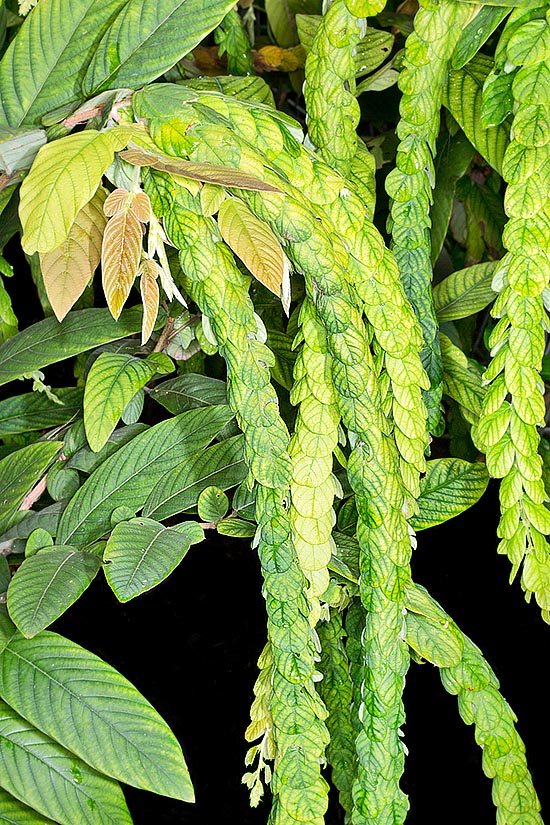Family : Fabaceae

Text © Pietro Puccio

English translation by Mario Beltramini

Phyllodium pulchellum is a 0,5-1,8 m shrub of South-East Asia with medicinal virtues © G. Mazza
The name of the genus is the combination of the Greek substantive “φύλλον” (phyllon) = leaf and of the suffix “-οειδής” (-oeidés) from “εἶδος“ (êidos) = shape, look, therefore similar to a leaf, with reference to the bracts enclosing the flowers; the specific name is the Latin adjective “pulchellus, a, um” = pretty, graceful.
Common names: ang-prom, prae kraoy (Cambogia); pai qian cao, pai qian shu (China); jatsalpan, jenukaddi, kadumuduru, karrantinta, katumudura, lodram, salaparni, sarivi (India); uchiwa-tsunagi (Japan); ked linz no:yz (Laos); serengan kechil (Malaysia); payang-payang (Philippines); klet plaa chon, yaa song plong, yaa klet lin (Thailand); cây chuỗi tiền, cây đồng tiền, chuỗi tiền, tràng quả đẹp, vảy tê tê đẹp, xìa tiền (Vietnam).
The Phyllodium pulchellum (L.) Desv. (1813) is a perennial deciduous tree, 0,5-1,8 m tall, with greyish pubescent branches and leaves, on a 1-2,5 cm long petiole, trifoliate, with ovate to elliptic to obovate leaflets with entire margin and obtuse apex, the terminal 6-10 cm long and 3-6 cm broad, the lateral ones 3-6 cm long and 2-4 cm broad, slightly pubescent above, pubescent below.
Panicle terminal and subterminal inflorescences, 8-25 cm long, bearing at each node of the floral axis 1-6 white or white yellowish papilionaceous flowers, about 0,5 cm long, united in sessile umbels enclosed at the base in a pair of bracts similar to leaves of ovate or circular shape, 1,2-1,8 cm long and of 1-1,5 cm of diameter. The fruits are flat, oblong legumes, about 0,6 cm long, usually containing two elliptic or circular seeds, about 0,25 cm long, of yellowish colour.
It reproduces by seed in draining organic loam, maintained humid at the temperature of 24-26 °C, with times of germination of 5-7 days. Species with the characteristic inflorescences relatively diffused in the origin places, but almost unknown elsewhere, requires a tropical or humid subtropical climate, and exposition in full sun or slightly shaded and draining soils, rich of organic substance, maintained almost constantly humid.
All parts of the plant are variously utilized in the popular medicine, in particular in the Chinese and Indian ones for various pathologies, but most frequently as antipyretic, antiphlogistic, antidiarrheic and diuretic.
Synonyms: Hedysarum pulchellum L. (1753); Zornia pulchella (L.) Pers. (1807); Dicerma pulchellum (L.) DC. (1825); Desmodium pulchellu (L.) Benth. (1852); Desmodium pulchellum (L.) Benth. (1852); Meibomia pulchella (L.) Kuntz (1891).
→ To appreciate the biodiversity within the family of FABACEAE please click here.
